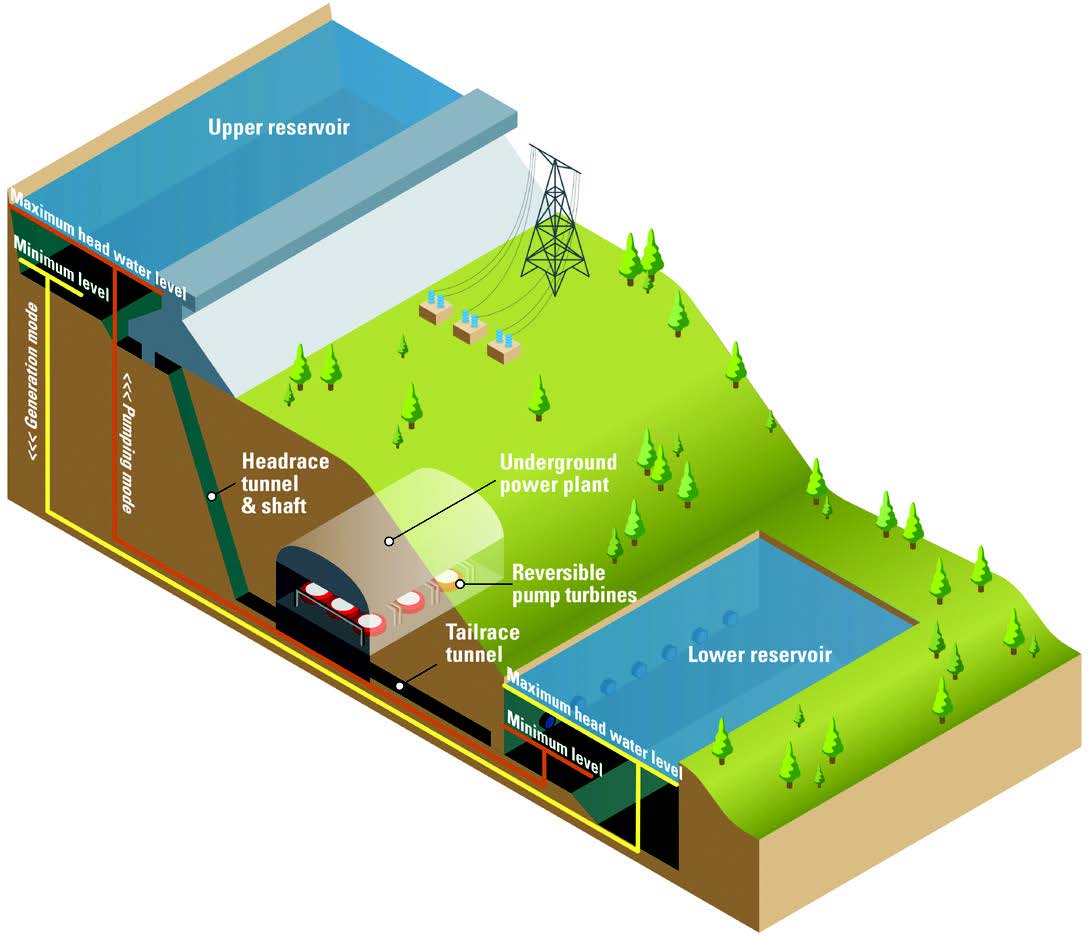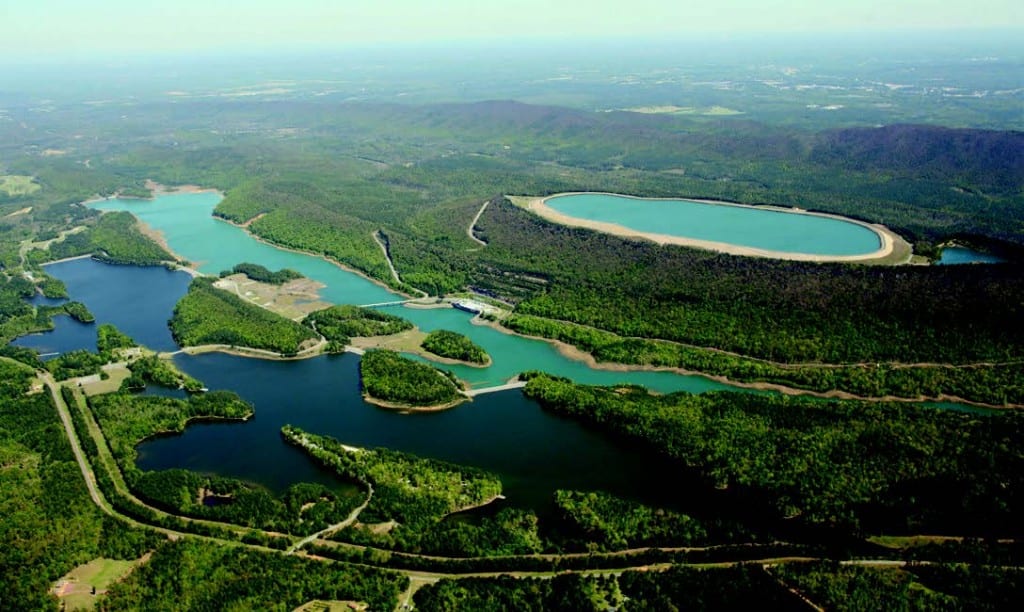Craig McMaster of water and natural resources specialist MWH explains why additional pumped storage hydropower could help the UK manage the variability of renewables
Is electricity storage the answer to the variability dilemma presented by renewables? Could additional storage release or enable a true renewables revolution in the UK? There’s general agreement within UK industry that an additional 2GW of electricity storage is needed to help balance and manage the lev- els of renewable power expected to have come online by 2020. We already have proven technology on a scale that can meet this ad- ditional electricity storage require- ment: Pumped storage hydropower (PSH).

What is PSH?
Electricity network generators and network operators in the UK have been using PSH on a large scale since the 1960s. The UK currently has four grid-scale PSH facilities in operation, located at Dinorwig, Ffestiniog, Cruachan and Foyers. This small fleet of pumped stor- age facilities was constructed be- tween the 1960s and 80s, with the primary motivation being to sta- bilize the power generation of the UK’s growing fleet of thermal and nuclear power stations. Pumped storage does this by absorbing the excess electricity generated during off-peak hours and deliver- ing stored energy during on-peak hours.
Over the years and with deregu- lation of the electricity market and the creation of spot markets, the use of PSH projects has developed to offer a range of benefits.
The concept of PSH is simple but the construction is not. A PSH sys- tem might comprise two bodies of water at differing elevations (upper and lower reservoir) connected by a pipeline. Reversible-pump turbines generate power or return water to the upper reservoir. When excess electricity exists within the grid the machines go into pumping mode, lifting water to the upper pond. When demand within the network exceeds available supply the ma- chines reverse, releasing water from the upper pond – the generat- ing mode. The system is a net user of electricity in lifting water to the upper reservoir but it generates commercial profit by trading high value electricity during periods of demand.
Why is PSH useful in managing grid issues with renewables? Pumped storage hydropower can exist in a symbiotic relationship with modern renewable and nucle- ar electricity generation. Indeed, PSH supports the development of renewable energy and contributes greatly to the decarbonisation of a nation’s power grid. PSH offers this support to renewables through a number of capabilities, namely: load following, frequency regula- tion, voltage regulation, fast re- serve and black start.
Load following is the most appar- ent capability offered by PSH. The system operates like a recharge- able battery and allows the grid operator to follow the electrical load demands within the network. When electricity supply is high but demand is low the PSH system can be used to absorb and store the excess power. Conversely, when supply is not sufficient to meet de- mand the load requirements can be met by the PSH facility switching to generating mode.
Frequency regulation is a form of automated balancing that is reactive to grid frequency, increasing or reducing in output on a second-by- second basis to re-balance generation to meet customer demand. PSH units operating on this regime are sent a start and stop command by the national grid during agreed windows of availability. This re- quires that the generators are kept spinning in air in order to achieve the required start-up times.
A fast reserve capability supports rapid amendment of generating levels and reliable provision of ac- tive power at very short notice to meet sudden increases in demand such as TV pickups or to meet un- expected generation shortfalls of thermal or nuclear plants, such as might occur during shutdowns.
And the Black start capability provides power resilience. Should a large thermal power station or nu- clear power station fail, PSH units can be used to restart the asset.
There has been no new PSH in the UK for the last 32 years, but
with the ongoing expansion of renewables, the risk of power loss from a single-point failure could soon rise significantly. Increasing the variability between demand and supply brings with it a growing requirement for PSH.
Power utilities and private devel- opers in the UK seem to support this view and the past five years has seen an increase in the number of sites assessed for both large and small-scale PSH.
Indeed across Europe, a renais- sance in PSH is happening almost entirely driven by the increase in highly variable renewable energy. Many European countries have brought on-line large PSH facilities to help manage the intermittency issues associated with renewable power. So it seems the UK is lag- ging in this PSH renaissance. Why? The answer lies in policy and the electricity generation market that evolves from it.
Whilst there is an intent to devel- op PSH in the UK, these projects face challenges given their long gestation periods of up to 10+ years. The balancing principle of PSH means that the operat- ing profile of the plant cannot be determined in advance, making it difficult to secure long-term con- tracts.
The current mechanisms are weighted towards maintaining existing generating infrastructure and fail to reflect the investment criteria for new-build projects.
Scotland is particularly well placed to capitalise on any po- tential PSH renaissance given its topography, available land, water resources and the growth in its wider renewable energy market. However, these invest- ment obstacles are a real barrier to progress.

The 1960s and now
Pumped storage hydropower was introduced to the UK during the 1960s when the nationalised pow- er industry recognised the need for a facility to help manage network issues associated with a particular type of electricity generation fleet i.e. nuclear and thermal genera- tion. The present situation doesn’t seem so straightforward. We have power stations coming on-line that also cause intermittency issues to grid operators but the lack of clear policy, regulation and clarity about long-term trading conditions cause a real dilemma for both utili- ties and developers. The need for large scale storage seems as rel- evant today as it did in the 1960s but the dynamic within the nation’s power industry and political landscape seems more clouded, even despite the benefits presented by PSH and the relatively low capac- ity levels in the UK.
There is a lack of substantive government encouragement for PSH which is currently not recognised within the Electricity Market Reform (EMR) framework. The technology and the resource ex- ists to push for an expansion of renewables in the UK, supported by PSH; all we need is the political will to make it happen.







